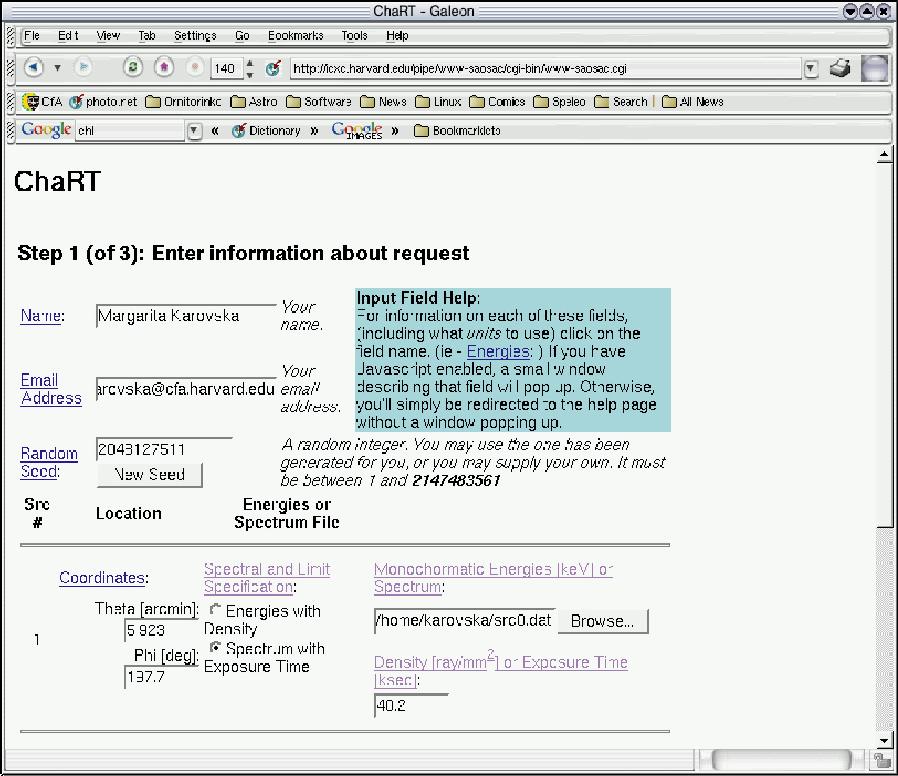Previous Next Contents
Simulating Chandra PSFs with ChaRT
ChaRT (Chandra Ray Tracer) is a user-friendly web interface that allows the user to simulate High Resolution Mirror Assembly (HRMA) Point Spread Functions (PSFs) at any off-axis angle and for any energy or spectrum. Realistic PSFs including instrument effects can be simulated using the ChaRT ray files as an input in MARX (Wise et al. 1997).
ChaRT can be accessed from the following web page:
http://cxc.harvard.edu/chart/.
Chandra produces sharper images than any other X-ray telescope to date and therefore provides an opportunity for high-angular and spectral resolution studies of X-ray sources. Crucial to these studies is the knowledge of the characteristics of the PSF. The blurring of the Chandra images is introduced by the HRMA PSF, the aspect solution, the limited size of detector pixels and detector effects. Simulating the HRMA PSF is the first and most important step in obtaining a good model of the Chandra PSF for a given observation. The shape and size of the HRMA PSFs vary significantly with source location in the telescope field of view, as well as with the spectral energy distribution of the source. Therefore, in order to carry out spatial analysis of Chandra data, each PSF must be simulated individually.
Until recently, the HRMA PSF models were available via standard PSF library files consisting of 2-D simulated monochromatic PSF images, "postage stamps'' (Karovska et al. 2000). These PSF images were made only for 5 monochromatic energies (ranging from 0.277 keV to 8.6 keV). They are stored in multi-dimensional FITS hypercubes with azimuth and elevation steps of either 1 arcminute or 5 arcminutes. The usage of the standard PSFs libraries for a detailed spatial/spectral analysis has limitations including interpolation over the coarse energy and spatial grids (especially for large off-axis angles), fixed number of photons and energies, and lack of instrument (detector) effects.
ChaRT provides the user with access to the best available mirror model, including many of the details of the HRMA's physical construction and a detailed model of the reflective properties of the mirror surface. ChaRT software runs remotely the SAOsac set of routines (used internally at the CXC for studies and calibration of the HRMA optics, see Jerius at al 1995). The software verifies and submits the user's simulation parameters and notifies the user when his/her files are available to download via FTP. More details about the software and imlementation are available in Carter et al. 2003.
The output of ChaRT is a FITS table containing a collection of rays.
In order to create a model PSF image, it is necessary to project the
rays onto the detector and take account of detector effects. The
output from ChaRT can be fed through the MARX software package (http://space.mit.edu/CXC/MARX/) that contains detailed models for the focal plane geometries of the various Chandra detectors. Standard CXC FITS files can be created from the output for subsequent processing with CIAO or other software.
A set of ChaRT threads were designed to guide the user and can be
accessed from the ChaRT page:
http://cxc.harvard.edu/chart/threads.
With the combination of ChaRT and MARX, users may easily perform detailed simulations of the Chandra PSFs. However, ChaRT and MARX have their limitations of which users should remain aware. The ChaRT web pages describe these limitations and caveats in detail.
Margarita Karovska and the ChaRT Team

Figure 17: The sample web page shows an example of a ChaRT parameter
interface for a simulation of a PSF at 6 arcminutes off-axis with a
spectrum file provided by the user. The off-axis location in the
sample web input page is Theta=5.923 arcminutes, Phi=197.7
degrees. The exposure time is 48.2 ksec. and an ascii spectrum file
src0.dat, (output from Sherpa), was provided by the user.
References
Carter et al. 2003, in in ASP Conf. Ser., ADASS XII in press.
Jerius, D. et al. 1995, in ASP Conf. Ser. Vol. 77, ADASS IV, ed. R.A. Shaw, H. E. Payne, & J.J.E. Hayes (San Francisco: ASP)
Karovska, M. et al. 2000, in ASP Conf. Ser. Vol. 238, ADASS X, eds. F.R. Harnden, Jr., F.A. Primini, & H.E. Payne (San Francisco: ASP)
Wise, M. et al. 1997, in ASP Conf. Ser. Vol. 125, ADASS VI, eds. G. Hunt & H.E. Payne (San Francisco: ASP)
Previous Next Contents
